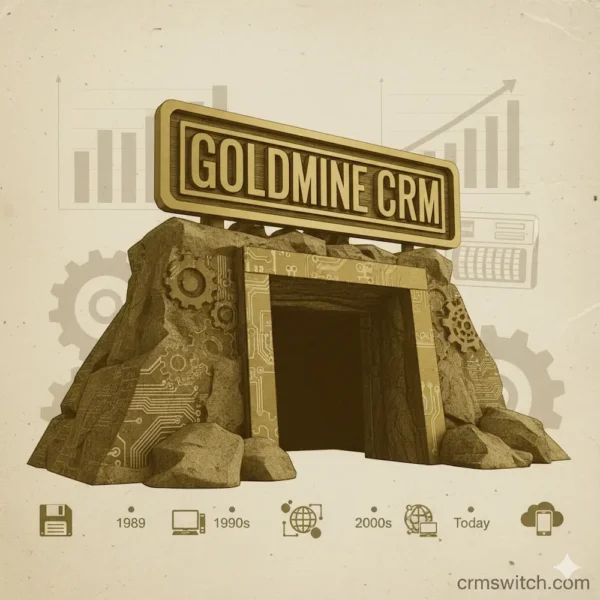Since the mid-1980s, CRM software has undergone an incredible evolutionary process. From a basic contact management platform, equivalent to a digital Rolodex, it has transformed into a robust system for managing all customer-facing business processes.

There have been many ups and downs along the way, and many vendors failed to weather the changes. However, one of the earliest, perhaps even the first, true CRM vendors is still alive and kicking.
GoldMine started strong and has remained popular for nearly a quarter of a century. Given its continued popularity, it’s worthwhile to examine its past, present, and future.
The 1980s: Filling A Void
In 1989, when most companies were still using dot-matrix printers, Elan Software founders Jon Ferrara and Elan Susser were looking to the future. As former computer science students at California State University, Northridge, they knew that computer networks were the future of business.
From their apartment in the San Fernando Valley, they began working on software to help transform the business landscape. Using a borrowed telephone line and personal savings, they worked sixteen-hour days to create GoldMine.
The business world already had digital contact managers, email clients, calendar applications, and more. What it didn’t have, and what John Ferrara and Elan Susser were trying to create, was a single piece of software that could handle all of those functions and be accessible across a network.
They envisioned a world in which salespeople didn’t have to run back to a specific computer to access customer data. This important distinction would set their software apart from all other products on the market. In May 1990, they fired the first shot in the CRM revolution with the release of GoldMine 1.0.
According to this LinkedIn post from Brenda Christensen, the company’s former board director, GoldMine was launched to the media in 1993.
As an aside, in 2017, I interviewed Jon Ferrara about his current venture, Nimble.
The 1990s: Controlled Growth and Critical Acclaim
Intent on maintaining creative control over their company, Ferrara and Susser rejected early venture capital offers. Choosing instead to live solely on the revenues generated by GoldMine, they continued to push out improved versions of their CRM software. The revenue growth allowed them to move out of their apartment and into an office, and their creative control allowed them to focus on product quality. That focus on quality paid off big-time in 1993.
From 1993 to 1997, they were awarded PC Magazines’ “Editor’s Choice” award four times. This brand recognition won them contracts with companies like Hewlett-Packard, Toshiba, Bank of America, and others. By 1995, they had moved GoldMine’s corporate offices to Pacific Palisades, fulfilling their early dream of an ocean view. By the close of the decade, they had won over 60 industry awards and had annual revenues nearing $25 million.
In May of 1999, GoldMine was purchased by a South African technology company named iXchange for a reported $83 million. In 2000, iXchange was renamed FrontRange Solutions Inc., and continues to develop GoldMine.
If you’re curious what the user experience was in the 90s, GoldMine 4.0 from 1998 is available for download from WinWorld.

The 2000s: Keeping Up With The Times
Throughout the 2000s, GoldMine released a wide variety of updates, new versions, and enhanced features. Some of their new product offerings included Business Contact Manager, FrontOffice, and, toward the end of the decade, GoldMine Mobile Edition. They also added Premium and Enterprise editions, along with support for popular Office applications like Outlook and Exchange, as well as integration with accounting software like QuickBooks.
While the 2000s didn’t see the explosive growth of the 80s and 90s, it did see something that may be more important—stability. When GoldMine launched, it was one of the few true CRM offerings available. By the 2000s, the market had been flooded by CRM vendors of varying quality and pricing. Some lesser companies didn’t survive the competition, and it’s a testament to GoldMine’s model that they maintained market share in a highly competitive market.
In December 2005, FrontRange was acquired by a private equity firm called Francisco Partners, but continues to operate as FrontRange Solutions under the umbrella of its new parent company.
In 2012, FrontRange separated its core businesses, creating a separate division for GoldMine to better focus on CRM development.
2010-2020: A Proven Formula
GoldMine continued to offer new versions and features on a regular basis. GoldMine Premium Edition 9.2 was available in a three-user bundle for $1,695 or a five-user bundle for $2,995 per annum. GoldMine also introduced a mobile solution for iOS users. Through their partnership with EarthLink in June 2013, GoldMine was able to offer secure cloud hosting to its customers.
GoldMine’s critical reception hasn’t cooled much over the years. They continued to win accolades and awards from a variety of industry analysts. GoldMine boasted over one million users in forty-five countries and earned a 1.8% market share in our U.S. CRM Market Share study, putting them solidly in the middle of the pack.
2020 to Present: Ownership by Ivanti
The ownership landscape for GoldMine shifted again following its time as a division of FrontRange. FrontRange Solutions was acquired by the private equity firm Clearlake Capital in 2016 and merged with HEAT Software. In January 2017, this new entity merged with LANDESK and was officially rebranded as Ivanti.
From 2020 to the present, GoldMine has operated as a product line within Ivanti’s broader portfolio of IT asset management, security, and service management solutions. Ivanti continues to release updates and new versions, such as GoldMine Premium Edition 2024, providing ongoing support and development for the product’s established and loyal customer base.
Into the Future
With over three decades worth of development, feedback, and updates under its belt, it’s no surprise that GoldMine has a large base of loyal users. Many companies that started using GoldMine 20 or more years ago still use it today and have built entire business processes around its deeply layered functionality.
The challenge for GoldMine going forward will be to maintain and grow its client base in the face of a vastly different CRM software landscape than the one it helped pioneer in the 1990s. While it was once the go-to solution for business CRM, today’s enterprises should carefully evaluate various products before making a selection.



